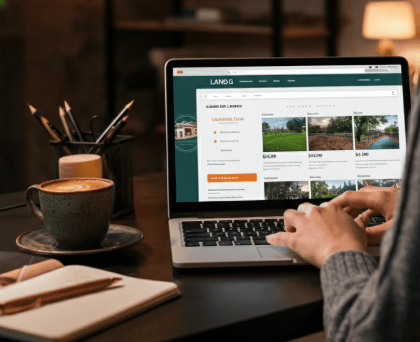Flipping land has gained significant traction as an investment strategy, but many wonder, “Is land easy to flip?” Unlike traditional real estate, land flipping often requires less capital and comes with fewer complications, such as repairs and tenant issues. Studies show that some investors achieve returns exceeding 100% on land deals, making it an attractive option for maximizing profits. Renowned real estate professionals Steve Daria and Joleigh, celebrated for their expertise in making cash offers on land, highlight the critical role of in-depth market research and strategic planning in achieving success. Whether you’re a seasoned investor or new to the game, mastering the art of land flipping is key to unlocking lucrative opportunities in this niche market. If you ask, “Is land easy to flip?” the answer depends on your knowledge, approach, and ability to spot opportunities. Take the next step toward financial success and book a free discussion with Steve Daria and Joleigh today to explore how you can thrive in land flipping!
What does flipping land mean?
Land flipping is the process of purchasing land at a low price and later reselling it at a higher value to earn a profit.
Unlike flipping houses, this process usually doesn’t involve renovations or repairs, making it simpler for many investors.
Successful land flipping often depends on identifying undervalued properties in areas with growth potential, such as those near developing communities or expanding cities.
Investors may use strategies like direct mail campaigns or researching tax delinquent properties to identify motivated sellers.

Many beginners ask, “Is land easy to flip?” The answer varies depending on the investor’s market knowledge and willingness to research and plan.
The profitability of a land flip is shaped by several key factors, including zoning regulations, market demand, and access to utilities.
Since land is typically less expensive than houses, it can also be a more accessible starting point for first-time investors.
With careful planning and strategy, flipping land can yield substantial financial rewards.
Get Started: Get Your Cash Offer Below…
We are direct land buyers. There are no commissions or fees and no obligation whatsoever. Start below by sharing where your property is and where we can send your offer…
Is land easy to flip in all markets?
Flipping land isn’t equally easy in all markets, as success depends on several factors, including location, buyer demand, and market conditions.
Some areas with high growth potential, like expanding suburbs or regions near planned developments, make land flipping easier and more profitable.
On the other hand, rural or isolated locations may have fewer buyers, making sales more challenging.
Zoning laws can also influence land value, property taxes, and access to utilities, all of which vary by region.
Many investors wonder, “Is land easy to flip?” The answer largely depends on the research and strategy an investor is willing to put in.
Markets with strong economic growth or increasing population often provide better opportunities for quick and profitable flips.
Success requires a thorough assessment of the local market, including a deep understanding of its unique challenges and opportunities, before making any investment decisions.
What are the risks of land flipping?
- Market Fluctuations: Land values can be unpredictable, often impacted by market shifts, economic downturns, or changes in demand. This volatility can make it challenging to sell the land at a profit, potentially leaving your investment tied up for longer than anticipated.
- Hidden Costs: Land flipping may seem straightforward, but there can be unexpected expenses, such as property taxes, legal fees, or costs for clearing and surveying the land. These hidden costs can erode your profit and make a deal less lucrative.
- Zoning and Land Use Issues: If land is zoned for a specific purpose, such as agricultural use, it may limit your pool of potential buyers. Changing zoning or obtaining permits can be a lengthy and costly process that delays your sale.
- Lack of Infrastructure: Land without access to water, electricity, or roads often takes longer to sell because it appeals to a smaller number of buyers. Adding these utilities can boost value, but it requires significant time and money, thereby increasing risk.
- Difficulty Finding Buyers: Selling land can take longer than selling houses because the buyer pool is smaller. If demand is weak in your chosen market, you could face long holding periods and ongoing costs before making a sale.

What tools can help with land flipping research?
Several tools can make land-flipping research easier and more effective.
Online property listing platforms, such as Zillow and LandWatch, are great for finding available land and comparing prices.
Geographic Information System (GIS) software helps you analyze land features, zoning, and nearby developments.
Public records, including county websites, provide details on property taxes, liens, and ownership history.
Many investors use Google Earth to study the terrain and surrounding areas for a better sense of the property’s potential.
Financial calculators are invaluable tools for estimating costs and projecting potential profits, providing a practical and informed foundation for effective financial planning.
People often ask, “Is land easy to flip?” This depends largely on how well you use these tools to gather accurate and useful information.
Forums and social media groups tailored to land investors serve as valuable networking platforms, offering both expert advice and valuable market insights.
Utilizing these tools empowers you to make more informed decisions, significantly enhancing your likelihood of success.
How can I estimate the potential ROI on a land flip?
1. Start with the Purchase Price
The first step to estimating ROI is knowing exactly how much you’ll spend on the land.
This encompasses the purchase price, closing costs, and any upfront fees.
People often wonder, “Is land easy to flip?” Understanding your upfront costs is crucial to answering this question and evaluating the opportunity.
2. Factor in Improvement Costs
If the land requires improvements, such as clearing or adding access roads, estimate those costs upfront.
These expenses can significantly impact the ROI, so be realistic about how much will be required.
This step helps confirm whether investing in a particular land flip makes financial sense.
3. Research Comparable Sales
Look into recent sales of similar properties in the area to estimate how much your land could sell for.
Tools like Zillow or LandWatch can help with this research.
Asking yourself, “Is land easy to flip?” often depends on how well you understand the market and comparable property prices.
4. Include Ongoing Expenses
Don’t forget to account for holding costs, such as property taxes, loan interest, or maintenance, during the time you own the land.
These recurring expenses can add up and reduce your future profits.
Ensure that you account for them when calculating your potential return on investment.
5. Calculate the Final ROI Formula
Use the basic ROI formula of [(Sale Price – Total Expenses) ÷ Total Expenses] x 100 to get a percentage.
This will provide you with a clear picture of the profit you can expect to make.
By being thorough in your calculations, you’ll better understand whether the deal is worth pursuing.
How do I get started with land flipping?
Getting started with land flipping involves a few clear steps to set yourself up for success.
First, research potential markets to find areas with growth opportunities and affordable land prices.
You’ll also want to learn about zoning laws, property taxes, and other factors that can influence your investment.
Many people ask, “Is land easy to flip?” The answer often depends on your ability to plan wisely and use resources effectively.
Experts like Steve Daria and Joleigh, seasoned real estate investors and cash land buyers, focus on identifying properties with high demand and strong resale potential.
Connecting with the real estate community and learning from experienced professionals is a great way to grow your knowledge and gain useful insights.
Start small by purchasing one or two pieces of land to gain experience before making larger investments.
Utilize tools such as online listing platforms and public records to gather essential information about properties.
If you’re ready to take the first step in land flipping, connect with experienced investors or explore land-buying opportunities today!
Takeaway
- Local Market Knowledge is Vital: Researching the local market is the first step to understanding your potential success. This insight can help you assess if land is easy to flip in a specific area.
- Thorough Research Minimizes Risks: Utilize tools such as mapping software and public records to analyze property features, zoning laws, and ownership history. Being well-informed ensures you make smarter, low-risk investment decisions.
- Understand All Costs Upfront: Consider the purchase price, ongoing maintenance, and any potential improvements before making a purchase. Knowing these costs helps you calculate your return and decide if land flipping is financially viable.
- Simple Upgrades Can Add Value: Small changes, such as improving access or clearing overgrown land, can make properties more appealing to buyers. These enhancements must be affordable to maximize your profit potential.
- Learn from Experienced Professionals: Working with seasoned investors and real estate groups can offer invaluable guidance. Their experience provides clarity on important questions, such as “Is land easy to flip?” and how to execute successful deals.
**NOTICE: Please note that the content presented in this post is intended solely for informational and educational purposes. It should not be construed as legal or financial advice or relied upon as a replacement for consultation with a qualified attorney or CPA. For specific guidance on legal or financial matters, readers are encouraged to seek professional assistance from an attorney, CPA, or other appropriate professional regarding the subject matter.
